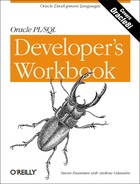Chapter 1. Declaring Variables and Naming Elements
Variables allow you to store and manipulate data—such as column values, counters, or calculations—inside your PL/SQL programs. There are two types of variables: scalar, which are made up of a single value, and composite, which are made up of multiple pieces (a record, for example, is represented with a composite variable). Whether composite or scalar, every variable has a name (also called an identifier), a datatype (such as NUMBER or VARCHAR2), and a value. This chapter tests your ability to work with these most basic PL/SQL elements.
Beginner
Intermediate
Expert
..................Content has been hidden....................
You can't read the all page of ebook, please click here login for view all page.
